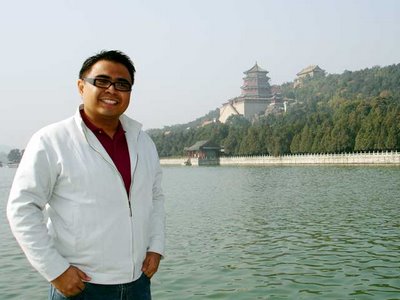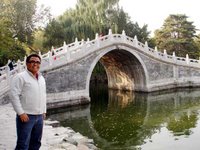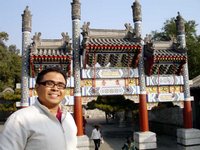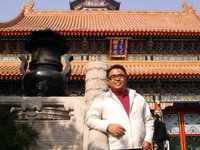 Today was our last day in Beijing. My two companions were leaving for Guangzhou at 1 p.m. So they had to prepare for the 22 hour train trip back. Marlon did some last minute shopping and was up really early. My train for Shanghai was leaving at 7 p.m. so I still had time for one more attraction. And today, I was scheduled to visit my fifth UNESCO World Heritage Site in Beijing, the Summer Palace.
Today was our last day in Beijing. My two companions were leaving for Guangzhou at 1 p.m. So they had to prepare for the 22 hour train trip back. Marlon did some last minute shopping and was up really early. My train for Shanghai was leaving at 7 p.m. so I still had time for one more attraction. And today, I was scheduled to visit my fifth UNESCO World Heritage Site in Beijing, the Summer Palace. Known as Yiheyuan (頤和園), which literally means "Garden of Nurtured Harmony," the Summer Palace was first built in 1750 as the Qingyiyuan (清漪園) or Garden of Clear Ripples. However, it was ransacked in 1860 by British and French forces, together with the old Summer Palace, the Yuanmingyuan (圓明園). The Yuanmingyuan was totally destroyed but the Qingyiyuan survived.
Known as Yiheyuan (頤和園), which literally means "Garden of Nurtured Harmony," the Summer Palace was first built in 1750 as the Qingyiyuan (清漪園) or Garden of Clear Ripples. However, it was ransacked in 1860 by British and French forces, together with the old Summer Palace, the Yuanmingyuan (圓明園). The Yuanmingyuan was totally destroyed but the Qingyiyuan survived. The current palace was rebuilt in 1886 by the Empress Dowager Cixi who diverted 30 million taels of silver meant for the Chinese navy to finance its construction. Cixi used it as her summer resort. It was christened Yiheyuan in 1888. In 1900, during the Boxer Rebellion, it was again damaged by an eight-nation allied invasion but survived. It was again reconstructed in 1902.
The current palace was rebuilt in 1886 by the Empress Dowager Cixi who diverted 30 million taels of silver meant for the Chinese navy to finance its construction. Cixi used it as her summer resort. It was christened Yiheyuan in 1888. In 1900, during the Boxer Rebellion, it was again damaged by an eight-nation allied invasion but survived. It was again reconstructed in 1902. Taking the cab was out of the question since the Summer Palace was quite a distance from the center of Beijing. I was told it was about 50 minutes by bus. For some reason, I was planning to leave at 8 a.m. but the next thing I knew, it was already 10 a.m. Hehe! Anyway, I was able to ask around which bus to take to the Yiheyuan and waitied at the bus stop. Just to be sure, I looked for the Chinese characters for Yiheyuan on the bus route posted at the stop and it turns out, the Summer Palace was the last stop of the bus. The cost of the bus was RMB5.
Taking the cab was out of the question since the Summer Palace was quite a distance from the center of Beijing. I was told it was about 50 minutes by bus. For some reason, I was planning to leave at 8 a.m. but the next thing I knew, it was already 10 a.m. Hehe! Anyway, I was able to ask around which bus to take to the Yiheyuan and waitied at the bus stop. Just to be sure, I looked for the Chinese characters for Yiheyuan on the bus route posted at the stop and it turns out, the Summer Palace was the last stop of the bus. The cost of the bus was RMB5. I finally arrived at the East Palace Gate of the Summer Palace after a long trip into the Beijing suburbs. I thought I could finish touring around in three hours but I under estimated its size since I found out that the complex covers an area of 290 hectares! So it was impossible to finish it before 3 p.m., the time I set for me to troop back to the city center to catch my train.
I finally arrived at the East Palace Gate of the Summer Palace after a long trip into the Beijing suburbs. I thought I could finish touring around in three hours but I under estimated its size since I found out that the complex covers an area of 290 hectares! So it was impossible to finish it before 3 p.m., the time I set for me to troop back to the city center to catch my train.The through ticket to the Summer Palace is RMB50. I also bought an English map of the place at RMB5 if I'm not mistaken. So I started my trek around the palace. There was no straight route to visit all the important structures since they were scattered around Kunming Lake and Longevity Hill.
 As soon as I entered, a structure covered in scaffolding welcomed me. Yikes! I hoped this was the only one being restored. It turns out it was the only one since restoration on many of the Summer Palace buildings had already been completed. I first dropped by the Garden of Virtue and Harmony which was built as a theater for Cixi. Inside is the Grand Stage (left), a three-storey theater stage which is the largest and best-preserved wooden stage in China, and is considered the "Cradle of Beijing Opera." Behind it is a two-storey make-up room which is now a showroom of Cixi's carriages and automobile, believed to be the first car imported into China.
As soon as I entered, a structure covered in scaffolding welcomed me. Yikes! I hoped this was the only one being restored. It turns out it was the only one since restoration on many of the Summer Palace buildings had already been completed. I first dropped by the Garden of Virtue and Harmony which was built as a theater for Cixi. Inside is the Grand Stage (left), a three-storey theater stage which is the largest and best-preserved wooden stage in China, and is considered the "Cradle of Beijing Opera." Behind it is a two-storey make-up room which is now a showroom of Cixi's carriages and automobile, believed to be the first car imported into China. From there, I tried to walk towards the Seventeen-arch Bridge but it was quite far and I didn't have enough time. So I took a photo with Kunming Lake (昆明湖) and Longevity Hill (万寿山) as a background and then trekked towards the Tower of the Fragrance of the Buddha which was on top of the hill. Also bought some dumplings for a quick lunch. On the way to the hill, you would walk through the Long Corridor (长廊), which at 728 meters is reputedly the longest corridor in the world.
From there, I tried to walk towards the Seventeen-arch Bridge but it was quite far and I didn't have enough time. So I took a photo with Kunming Lake (昆明湖) and Longevity Hill (万寿山) as a background and then trekked towards the Tower of the Fragrance of the Buddha which was on top of the hill. Also bought some dumplings for a quick lunch. On the way to the hill, you would walk through the Long Corridor (长廊), which at 728 meters is reputedly the longest corridor in the world. Welcoming you up the hill was the Hall that Dispels the Clouds or Paiyun Dian (left) which was built to celebrate Cixi's birthday. Inside were birthday gifts given to her by princes, dukes and high-ranking officials. I would have wanted to go up to the tower which housed a five-meter high gilded bronze statue of the Guanyin Bodhisattva cast in 1574; but time was against me. I still had a long walk and just an hour and a half left to go around. So I continued walking.
Welcoming you up the hill was the Hall that Dispels the Clouds or Paiyun Dian (left) which was built to celebrate Cixi's birthday. Inside were birthday gifts given to her by princes, dukes and high-ranking officials. I would have wanted to go up to the tower which housed a five-meter high gilded bronze statue of the Guanyin Bodhisattva cast in 1574; but time was against me. I still had a long walk and just an hour and a half left to go around. So I continued walking. Another attraction was the famous Marble Boat (石舫) also known as the Clear and Peaceful Boat. This 36-meter two-storey boat was carved out of a shadowy blue stone. It was a symbol of stability ofthe Qing Dynasty, an idea derived from the saying "Water can carry a boat, and it can also capsize a boat," serving as a warning to the emperor that he had to attend to state affairs with prudence.
Another attraction was the famous Marble Boat (石舫) also known as the Clear and Peaceful Boat. This 36-meter two-storey boat was carved out of a shadowy blue stone. It was a symbol of stability ofthe Qing Dynasty, an idea derived from the saying "Water can carry a boat, and it can also capsize a boat," serving as a warning to the emperor that he had to attend to state affairs with prudence. I was planning to exit via the North Palace Gate and it was still quite far. I passed by some trees which displayed autumn's colors but not as spledid as those we saw on the way to the Great Wall yesterday.
I was planning to exit via the North Palace Gate and it was still quite far. I passed by some trees which displayed autumn's colors but not as spledid as those we saw on the way to the Great Wall yesterday.Also on the way were some nice bridges and more old structures until I finally reached the Hall of the Buddha Confirming His Docrine, a temple which housed gargantuan statues of the Buddha and various Buddhist saints.
My last stop was Suzhou Street, a famous shopping street in the imperial gardens, imitating the shops along the canal in Suzhou. It was first built in 1751 and completely destroyed in 1860. The Chinese government totally rebuilt all the structures based on photos in 1991. The street is now an impressive assemblage of old shop houses. I hope they do this as well along the canals of Binondo since we have a lot of old photos of this charming area of Manila.
 I wasn't able to walk the entire area of Suzhou Street since it was already 3 p.m. and since it would take a while to get back to the city center, I decided to catch a bus. Outside was the stop for bus no. 808 which would take me to Tian'anmen Square. Again, the fare was RMB5. The trip was longer this time since traffic was heavy. The bus left at 3:30 p.m. and we were back in the city center at 5:15 p.m.
I wasn't able to walk the entire area of Suzhou Street since it was already 3 p.m. and since it would take a while to get back to the city center, I decided to catch a bus. Outside was the stop for bus no. 808 which would take me to Tian'anmen Square. Again, the fare was RMB5. The trip was longer this time since traffic was heavy. The bus left at 3:30 p.m. and we were back in the city center at 5:15 p.m. Since I didn't want to miss my train, I opted to take a cab back to the hotel to get my luggage and bring me straight to the train station. I arrived there at 6 p.m. which gave me just enough time to buy some dinner and then board the train to Shanghai. The trip was 12 hours and I was arriving in Shanghai at 7 a.m.
Since I didn't want to miss my train, I opted to take a cab back to the hotel to get my luggage and bring me straight to the train station. I arrived there at 6 p.m. which gave me just enough time to buy some dinner and then board the train to Shanghai. The trip was 12 hours and I was arriving in Shanghai at 7 a.m.
No comments:
Post a Comment